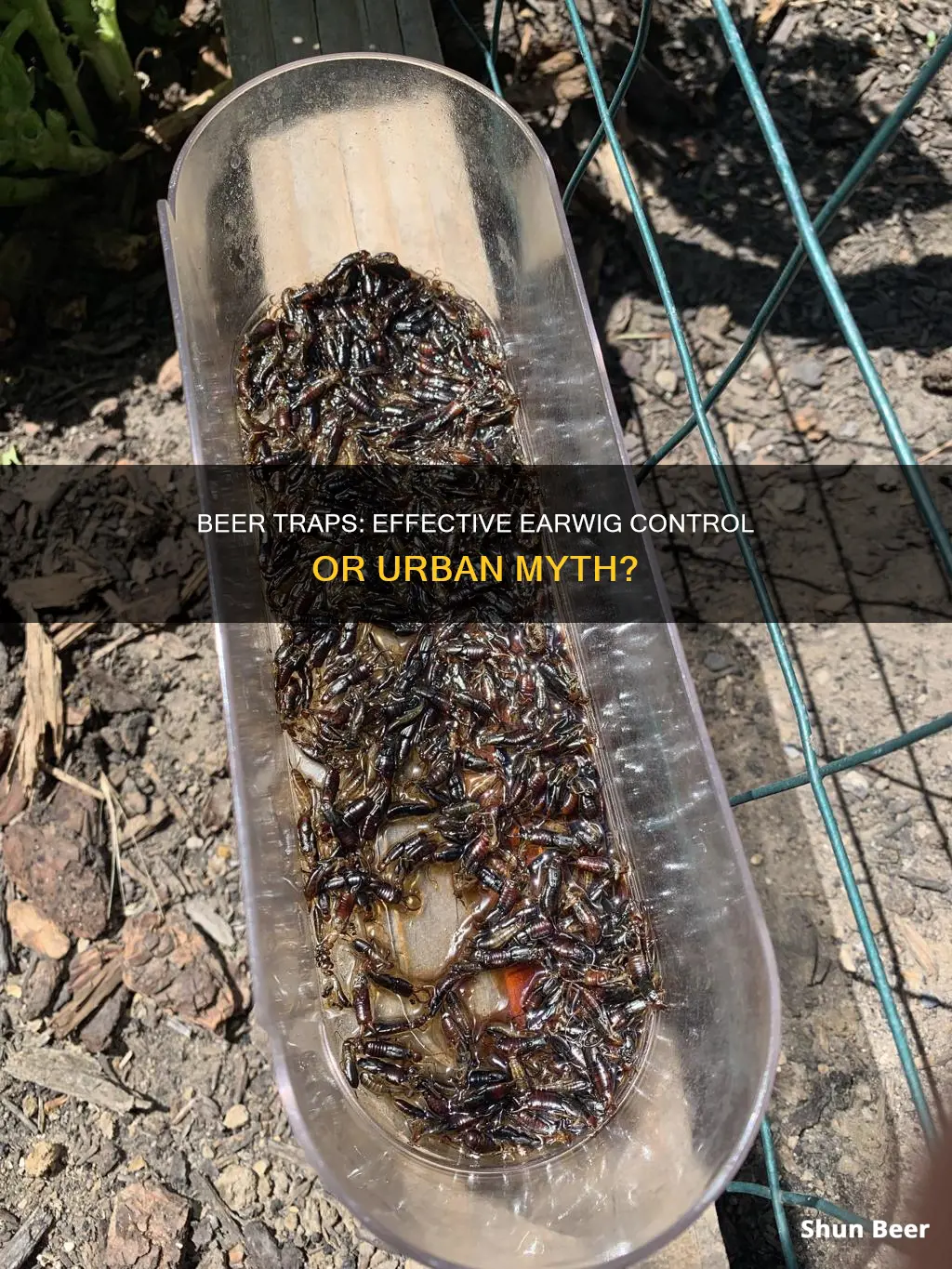
Earwigs are a common garden pest that can cause significant damage to plants. While there are various methods to control earwig populations, such as contact pesticides, systemic pesticides, and physical barriers, beer traps offer an easy, organic way to manage these pests. Beer traps are simple to make and effective in luring and trapping earwigs, providing gardeners with a useful tool to protect their plants from these pesky insects.
| Characteristics | Values |
|---|---|
| Effectiveness | Beer traps are a great, easy, and organic way to get rid of earwigs. |
| Ease of Use | Beer traps are easy to set up and use. |
| Cost | Beer traps are inexpensive and can be made with household items. |
| Maintenance | Beer traps should be checked and emptied every few days. |
| Completeness | Beer traps may not completely eliminate the earwig problem but can reduce the pest pressure. |
What You'll Learn

Beer traps are an easy, organic way to get rid of earwigs
To make a beer trap, start by digging a small hole in the soil near the affected plants. Place a small container, such as an old fruit cup or a tuna can, into the hole so that the top of the container is flush with the soil surface. Fill the container with beer, and you're done! The earwigs will be drawn to the beer and crawl into the container, but they won't be able to crawl out.
It's important to check your beer traps every few days to empty them of dead bugs and replenish the beer as needed. This method may not completely eradicate your earwig problem, but it can help reduce the population and ease the pressure on your garden.
In addition to beer, you can also use other baits such as soy sauce and vegetable oil. Some people have found success using a mixture of equal parts soy sauce and oil, with the soy sauce luring the earwigs and the oil trapping them. This method is not only effective but also cost-efficient.
Earwigs can be persistent pests, and it may take a combination of different approaches to manage them effectively. However, by using beer traps, you can control their population in a safe and organic manner, protecting your garden without resorting to chemical pesticides.
Do Beer Cozies Work? The Science Behind It
You may want to see also

How to make a beer trap
Beer traps are an effective, easy, and organic way to get rid of earwigs, slugs, and pill bugs. Here is a step-by-step guide on how to make a beer trap:
Step 1: Prepare a Container
Choose a small container that is about 2 to 3 inches tall and wide. You can reuse old containers such as fruit cups, yoghurt pots, or margarine tubs.
Step 2: Dig a Hole
Dig a small hole in the soil and place the empty container inside. Ensure that the top of the container is level with the soil surface.
Step 3: Add Beer
Fill the container with beer. The bugs, attracted by the beer, will crawl into the container but will be unable to crawl out.
Step 4: Maintain the Trap
Check the beer traps every few days to remove dead bugs and refill the container as needed. This method may not completely eradicate the pest problem, but it will help reduce the pressure on your garden.
In addition to beer, you can also use other baits such as a mixture of vegetable oil and soy sauce, or stale beer in small jars placed on their sides. These alternative traps work similarly to beer traps, luring earwigs and other pests and trapping them.
The Magic of Beer Widgets: How Do They Work?
You may want to see also

Other baits to use in earwig traps
While beer traps are a great way to catch earwigs, there are other baits that can be used in earwig traps. Here are some alternative baits to use:
Soy Sauce and Oil
A simple yet effective trap can be made using soy sauce and cooking oil. The soy sauce acts as an attractant, luring the earwigs into the trap, while the oil creates a dense layer that traps them, causing them to eventually drown. This trap can be set up by filling a small container with equal parts soy sauce and oil and placing it in areas where earwigs are active, such as against a wall or near plants they have been feeding on.
Vegetable Oil and Water
Another variation of the oil trap involves using vegetable oil and water. This trap is particularly effective for earwigs in the garden. To set it up, fill a small container one-third full with water and add a layer of vegetable oil on top. Bury the container in the soil, leaving the top slightly above the ground to prevent soil from falling into the trap. Cover the trap with a lid or saucer to protect it from rain. Earwigs will be attracted to the trap and will drown in the water, unable to escape due to the layer of oil.
Peanut Butter
For store-bought earwig traps, peanut butter can be used as bait. Simply add a small amount of peanut butter to the trap and place it in damp areas where earwigs are commonly found, such as bathrooms, cabinets, or around water heaters.
Olive Oil and Worcestershire Sauce
In addition to soy sauce, some people have found success using Worcestershire sauce as an attractant. Combine it with olive oil in a container and place it in areas where earwigs are active. The earwigs will be attracted to the scent and become trapped in the oil.
It's important to note that while these traps are effective, earwigs may not always be the primary issue. It's recommended to address the root cause of the problem, such as piles of wood or dead trees, to prevent future infestations.
Exploring Beer Enhancement With Bazooka Tubes
You may want to see also

How to dispose of earwigs caught in traps
Once your beer traps have caught a number of earwigs, you'll need to dispose of them. Here's how to do it:
Firstly, check your traps every few days and empty them of dead bugs. If you're using a simple beer trap, top it off as needed. If you're using a DIY trap with oil, you may want to reset the trap and dispose of the old one in the trash.
If you're using a store-bought trap, follow the instructions on the brand you've chosen. Some may require additional bait options like peanut butter or oil, while others are water-activated. Be sure to read the instructions to ensure your trap works correctly.
For DIY traps, you can simply throw the entire trap away, or, if you want to reuse the container, pour the contents into the trash and rinse the container. You can also use a lidded container, poke holes in the lid, and place it back on. This way, you can easily dispose of the contents without having to touch the bugs.
If you're using a flowerpot trap, simply remove the newspaper or straw, along with any earwigs, and replace it with fresh material.
It's important to note that some traps may attract larger critters, such as raccoons or skunks, so it's essential to keep your garden fenced if you're using bait that might lure these animals. Additionally, keep traps away from pets and small children, as the oil and bugs can be harmful if ingested.
Beer Bar Memberships: Are They Worth the Cost?
You may want to see also

Natural predators of earwigs
Beer traps are an effective, organic way to get rid of earwigs. But if you're looking for a more natural solution, you can try encouraging the natural predators of earwigs.
Earwigs are regularly preyed upon by a variety of creatures, including birds, toads, lizards, centipedes, spiders, and insects such as tachinid flies and assassin bugs.
- Birds: Create a bird-friendly garden by providing bird baths, bird houses, and plants that birds are attracted to, such as alyssum, calendula, dill, and fennel.
- Toads: Provide damp, shady hiding spots and a source of water.
- Lizards: Create a lizard-friendly habitat by providing rocks, logs, and other hiding spots.
- Centipedes: Encourage centipedes by reducing lighting around the foundation of your home and providing damp, dark spaces for them to hunt at night.
- Spiders: Attract spiders by reducing the use of pesticides and providing undisturbed spaces for them to build their webs.
- Tachinid flies: Plant alyssum, calendula, dill, and fennel to attract these flies, which are the primary insect predators of earwigs.
By encouraging these natural predators, you can help control the earwig population in your garden while also supporting biodiversity.
Beer Slug Traps: Do They Work?
You may want to see also







